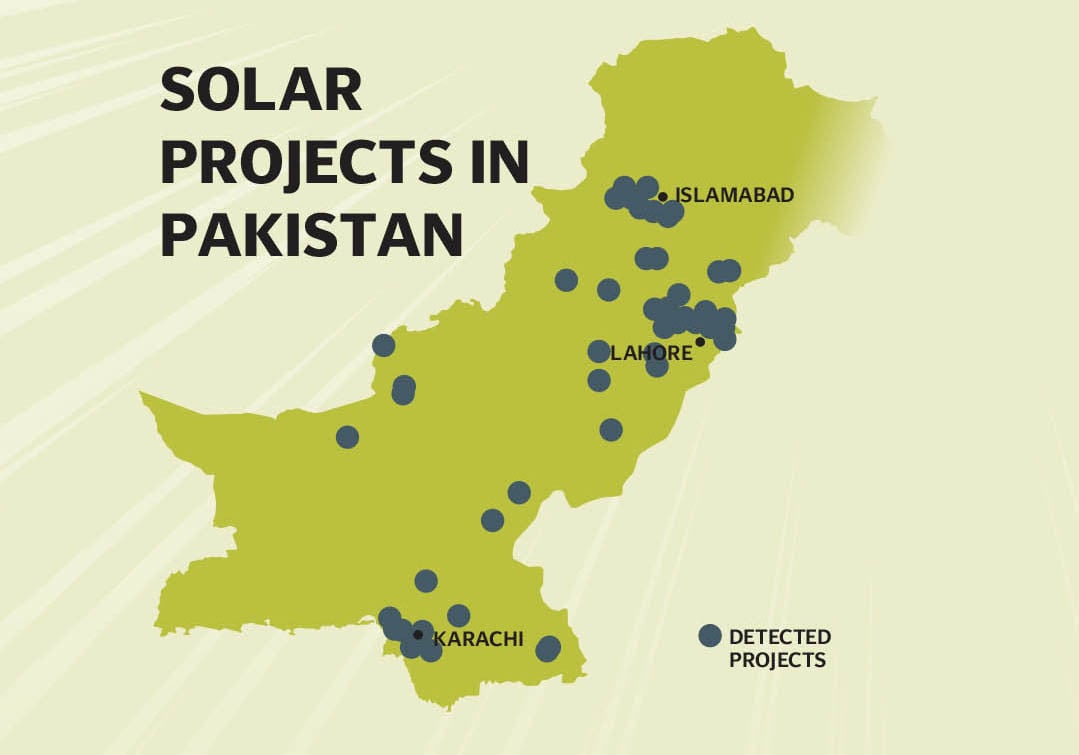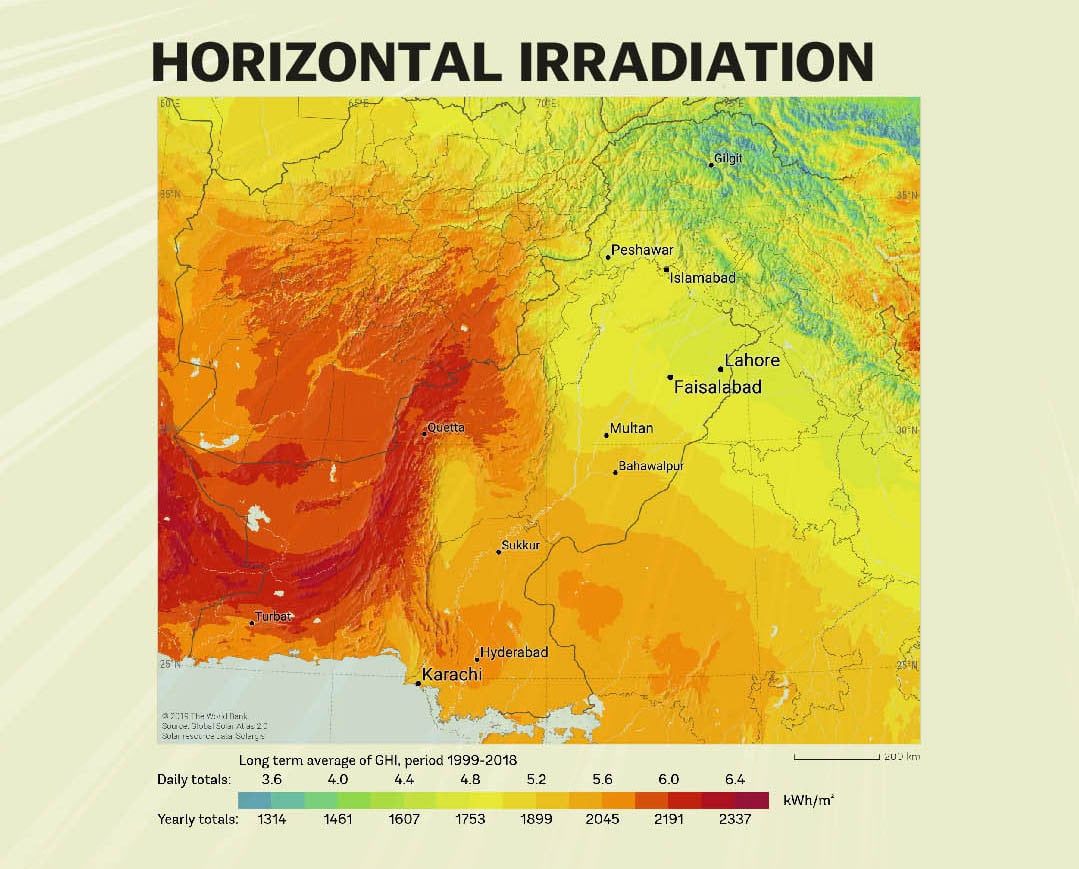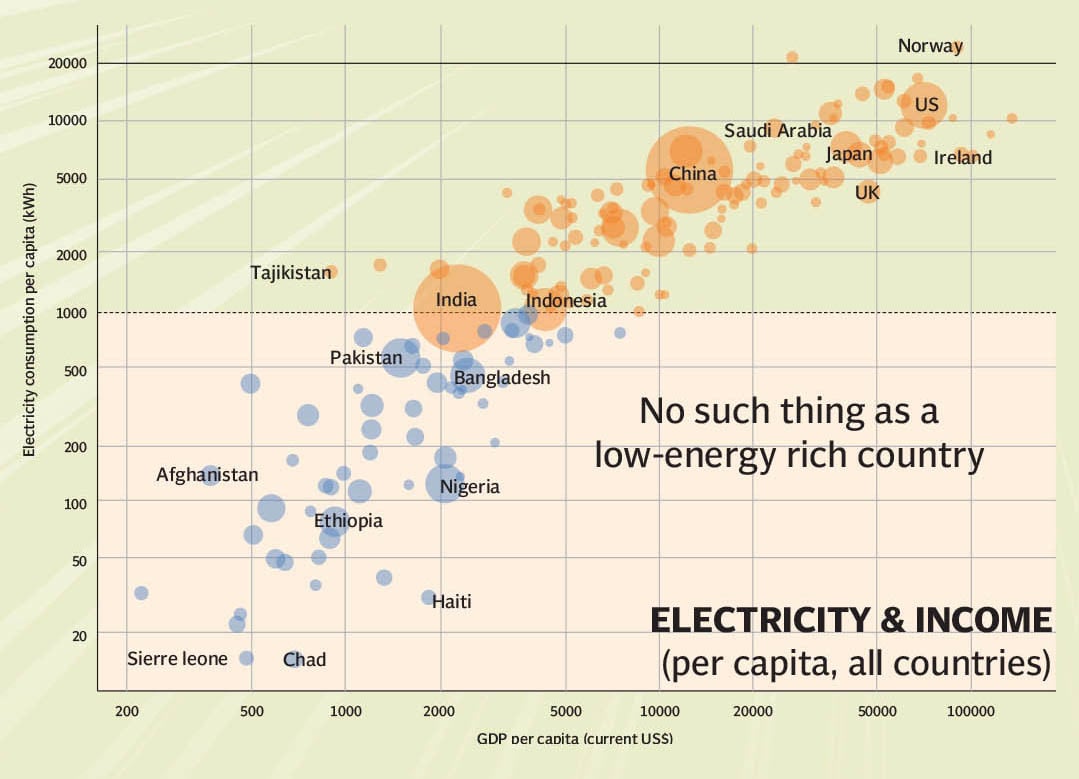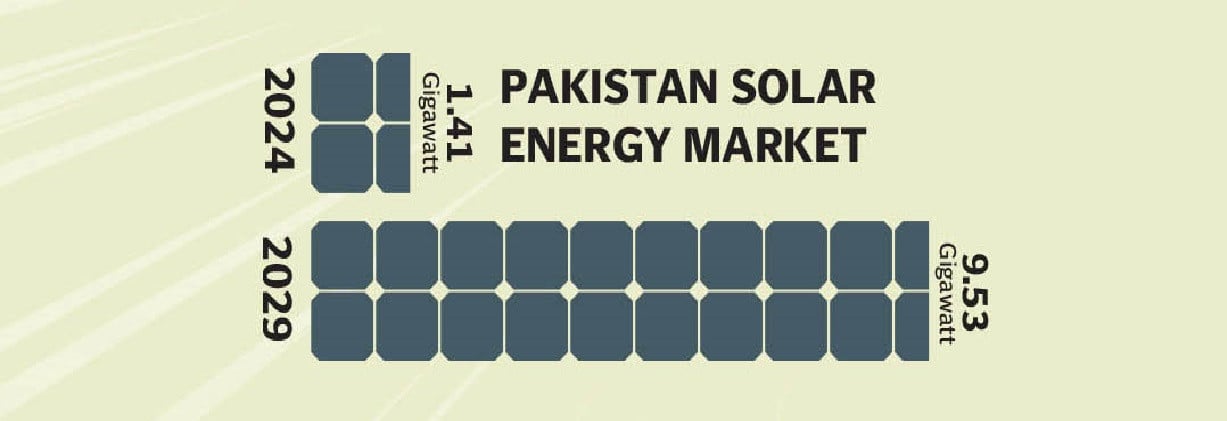Picture a Pakistan where the scorching summer sun no longer drains your wallet, but fuels your home. A Pakistan where energy scarcity is a distant memory, and the air is crisp and clean. A Pakistan where the reliability of electricity is no longer a concern, but a guarantee.
As of 2024, Pakistan has made remarkable strides towards this vision. With nearly 30% of its electricity consumption generated through solar power, the country is poised to become the third-largest importer of Chinese solar equipment and the sixth-largest solar market globally.
But can Pakistan take the leap and shift entirely to solar power? Will it be reliable? How soon can this transformation happen? And what does it mean for the average citizen?
As the country hurtles towards an unprecedented energy revolution, questions abound. Will traditional grid electricity become a relic of the past? How will solar energy impact the economy, employment, and public health?
As Pakistan's solar revolution gains momentum, one thing is clear: the future of energy is bright. With solar power already illuminating homes, industries, and lives across the country, the question on everyone's mind is - what's driving this remarkable growth? The answer lies in the numbers, and the numbers tell an astonishing story.

The rise of solar in Pakistan
Pakistan is experiencing a remarkable solar energy boom, driven by a combination of factors including soaring power prices, declining solar costs, and growing demand. According to BloombergNEF, the country imported an astonishing 13 gigawatts of solar modules in the first six months of 2023, making it the third-largest destination for Chinese exporters. This surge in imports has increased Pakistan's electricity capacity by 30%, a staggering achievement that has gone largely unnoticed.
The global solar market is also experiencing rapid growth, with 444 gigawatts of new solar photovoltaic capacity installed in 2023 alone. While solar power still accounts for just under 6% of global electricity, its share has nearly quadrupled since 2018, with no signs of slowing down.
Pakistan's solar market is booming, propelled by hikes in power prices over the past few years. The latest increase in July triggered widespread protests, leading to a drop in grid electricity consumption to its lowest level in four years. As a result, many Pakistanis are turning to independent solar solutions, driving demand for rooftop solar installations.
BloombergNEF analyst Jenny Chase notes, "Pakistan's market has the potential to continue to be very large. If solar is solving the market's power problems, there is no reason to expect a crash any time soon". The country is expected to add between 10 gigawatts and 15 gigawatts of solar capacity in 2024, mostly in the residential and industrial sectors, making Pakistan the sixth-largest market in the world.
The impact of Pakistan's solar surge is already being felt. Despite power prices soaring in the wake of Putin's Ukraine invasion, the country's economy has continued to grow, defying expectations. Sales of electricity have dropped by 10% in the last two years, yet the economy has grown by 2%. This paradox is largely due to Pakistanis embracing solar energy, buying cheap Chinese solar panels and installing them on their homes and factories.
However, a report by Mordor Intelligence suggests that Pakistan's solar energy market is poised for exponential growth, with the installed capacity expected to grow from 1.41 gigawatts in 2024 to 9.53 gigawatts by 2029, at a compound annual growth rate (CAGR) of 46.55%. This remarkable growth is driven by increasing adoption of solar PV systems, declining solar panel and installation costs, and rising environmental concerns.
The growing demand for renewable energy sources and declining solar costs are driving the adoption of solar PV systems in Pakistan. Additionally, reduced costs are making solar energy more accessible and affordable for residential, commercial, and industrial sectors. Rising environmental concerns are also shifting focus towards clean energy sources like solar power.
Despite these growth drivers, challenges persist. Transmission and distribution losses hinder the effectiveness of solar energy distribution, while the lack of clear policies and regulations may hinder market growth. Furthermore, intermittent solar power generation poses challenges for grid stability.
However, Pakistan's abundant solar irradiance and foreign investments present significant opportunities. Micro- and mini-grids can electrify rural communities, promoting energy access and economic growth. Incorporating solar power into generation, transmission, and distribution systems can enhance energy security.
The utility sector is expected to dominate the market, driven by government initiatives and upcoming projects. Pakistan aims to generate 30% of its power from renewable sources by 2030. Falling solar module costs and increasing project development will drive utility-scale solar adoption. Recent developments, such as Orient Energy Systems and JA Solar's 26-megawatt n-type utility-scale photovoltaic power plant and Hanersun Technologies' 500MW solar project, demonstrate the growing interest in Pakistan's solar market.
According to the International Renewable Energy Agency (IRENA), Pakistan's total solar installed capacity was 1,244 megawatts as of 2023, an increase of 17% compared to 2021. The country's government has proposed several efforts to raise the percentage of solar energy. With government support, these projects are expected to make the utility sector the dominant force in Pakistan's solar energy industry in the coming years.
As Pakistan's solar energy market continues to grow, understanding the current market dynamics is crucial for harnessing its full potential. The country's remarkable solar growth is also reflected in its soaring imports of solar modules, particularly from China, which have significantly boosted Pakistan's electricity capacity.

Pakistan's solar potential
Pakistan, strategically located in South Asia, boasts an immense potential for solar energy. With its abundant sunshine and growing energy demands, the country is poised to become a leader in solar energy production. According to recent statistics, Pakistan's solar energy market is experiencing exponential growth, driven by favorable policies, declining solar costs, and rising environmental concerns.
Pakistan receives an average solar radiation of 5-6 kWh/m²/day, making it an ideal location for solar energy generation. The country's geography, with vast deserts and arid regions, offers a unique opportunity for large-scale solar farms.
Pakistan's energy demands are increasing rapidly, with the country facing an energy deficit of around 5,000 MW. Solar energy can help bridge this gap, providing clean and reliable power to millions of Pakistanis.
The country's coastal regions hold significant potential for wind energy, while its average 9.5 hours of sunlight per day make solar energy an attractive option. Moreover, Pakistan aims to increase its hydropower capacity from 9,000 MW to 22,000 MW by 2030.
Recent projects demonstrate the growing interest in Pakistan's solar market. Orient Energy Systems and JA Solar completed Pakistan's first n-type utility-scale photovoltaic power plant project, with a capacity of 26 megawatts. Hanersun Technologies agreed to construct a 500MW solar system in the country, with an investment of around USD 700 million.
The Pakistani government has launched several initiatives to support the growth of the solar energy sector. The Alternative Energy Development Board (AEDB) has set a target of generating 30% of the country's power from renewable sources by 2030. The government has introduced net metering laws, allowing households and businesses to generate and sell excess electricity back to the grid. The AEDB has also established the Renewable Energy Development Fund to provide financing for renewable energy projects. Tax exemptions and customs duties have been waived for solar equipment imports to encourage investment in the sector
Pakistan's solar energy growth is expected to create jobs, stimulate economic growth, and reduce reliance on imported fossil fuels. According to the World Bank, every dollar invested in renewable energy generates up to three times more jobs than the same investment in fossil fuels.
Pakistan's solar potential is vast and untapped. With favorable policies, declining solar costs, and growing energy demands, the country is poised to become a leader in solar energy production.
In this journey to grow, the National Power Authority and local distributors will play a critical role in ensuring the seamless integration of solar power into the national grid. The National Power Authority and local distributors are also working and responding to the growing demand for solar energy, and are working to address the challenges and opportunities presented by this shift towards a cleaner, more sustainable energy mix.

Official perspectives
As Pakistan's solar energy market continues to grow, the National Electric Power Regulatory Authority (NEPRA) and local distributors, such as K-Electric, are playing a crucial role in ensuring the seamless integration of solar power into the national grid.
NEPRA has established policies and regulations to facilitate the growth of solar energy, including net metering and feed-in tariffs. Local distributors, such as K-Electric, are also taking proactive steps to integrate solar energy into their long-term energy planning.
According to Imran Rana, Senior Director Communications at K-Electric, "KE has already embarked on an ambitious plan to add 1300 MW of renewable energy in its generation mix under its Power Acquisition Program." This includes 640 MW of solar and wind projects in Sindh and Balochistan, including Pakistan's first 220 MW hybrid solar and wind project at Dhabeji.
K-Electric's renewable energy projects, totaling 640 MW across Balochistan and Sindh, are part of its Power Acquisition Programme (PAP) submitted to NEPRA in early 2023. This portfolio includes both wind and solar capacity to maximize energy yield, with solar projects in Balochistan and Sindh, and a hybrid project at Dhabeji.
However, integrating decentralized solar power into the grid poses challenges. One major concern is managing variability and ensuring grid stability. NEPRA and local distributors must address these technical challenges to ensure a reliable and efficient energy supply.
Net metering has been instrumental in promoting solar energy growth in Pakistan. The policy allows households and businesses to generate and sell excess electricity back to the grid. However, critics argue that net metering can increase electricity prices for grid users when energy generation exceeds consumption.
Rana acknowledges this concern, stating, "The debate around net metering is valid, but it's essential to consider the broader benefits of solar energy." He emphasizes that K-Electric's approach focuses on large-scale solar projects, which can provide economies of scale and reduce costs.
Interestingly, NEPRA's recent data reveals a 9.1% year-on-year decline in power consumption in 2023, primarily attributed to high power prices and reduced economic activity. Rooftop solar is considered a contributing factor, but only to a lesser extent.
Notably, Pakistan's solar capacity is expanding rapidly, with estimates suggesting around 12.7 GW of solar power already installed, compared to 48 GW of on-grid power capacity. The country is expected to add 10-15 GW of solar power in 2024 alone.
However, NEPRA faces challenges in tracking the exact solar capacity, highlighting the need for improved data collection and monitoring mechanisms.
“KE’s utility-scale renewable energy projects envisioned in the Power Acquisition Program are in line with NEPRA’s outlined guidelines. As the power sector operates in a regulated environment, KE ensures that NEPRA’s approvals and guidance are sought at every stage of the process,” said Rana.
Feed-in tariffs also play a crucial role in promoting solar energy growth. NEPRA has established tariffs for solar projects, providing a fixed price for electricity generated. This provides certainty for investors and encourages investment in the sector.
Despite challenges, local distributors like K-Electric remain committed to integrating solar energy into their energy mix. Rana notes, "KE aims to enhance the share of renewable energy to 30% in its mix by 2030." This ambitious target demonstrates the company's commitment to sustainability and reducing dependence on expensive imported fuels.
NEPRA and local distributors like K-Electric are taking proactive steps to integrate solar energy into Pakistan's energy mix. While challenges persist, the benefits of solar energy, including reduced costs and environmental benefits, make it an essential component of Pakistan's energy future.
It is essential to examine the opportunities and challenges that lie ahead. The key opportunities and challenges facing Pakistan's solar energy sector, including financing, technology, policy, and infrastructure considerations.

Opportunities and challenges
Pakistan's energy crisis has been a pressing issue, with the government's recent price hikes exacerbating the struggles of its population. Over the past year, Prime Minister Shehbaz Sharif's administration has increased energy prices to address the significant budget deficit. However, this move has led to widespread protests.
The government has attempted to alleviate the burden, with Maryam Sharif, Chief Minister of Punjab province, announcing a substantial subsidy program worth 45 billion rupees ($162 million). Despite these efforts, the country still lacks an affordable and sustainable electricity system, crucial for bridging the economic gap with other emerging economies.
Pakistan's energy challenges are multifaceted. The country relies heavily on imported energy sources, contributing to its economic woes. Additionally, the existing power grid is plagued by inefficiencies, leading to losses and increased costs. Furthermore, over 40 million people in Pakistan lack access to electricity, with half the population without clean cooking facilities.
The ongoing crisis has led to increased adoption of clean energy alternatives. As households and businesses seek alternatives, clean energy has emerged as a beneficiary of the crisis. Renewable energy sources, such as wind, solar, and hydroelectric power, offer a promising solution.
The increasing adoption of net metering has created challenges for local distributors like K-Electric, HESCO, LESCO, and iESCO in maintaining a balance between solar energy generation and grid stability. With more consumers generating their own electricity through solar panels, the demand for grid electricity decreases. However, the fixed costs of generating unused electricity are still borne by the distributors, which may lead to higher prices for grid users. This could disproportionately affect middle- and lower-class households, exacerbating energy poverty.
Industrial areas in major cities like Karachi and Lahore have already embraced solar energy, with many businesses installing large solar panels to ensure seamless electricity supply. Google Earth images reveal extensive solar panel coverage in industrial zones. While this shift reduces reliance on the grid, it also raises concerns about the distribution of benefits and costs.
 Pakistan's solar sector is also impacted by the issue of Independent Power Producers (IPPs). IPPs have traditionally dominated Pakistan's energy landscape, and their existing contracts may hinder the growth of solar energy. The government must carefully manage the transition to renewable energy sources while ensuring IPPs' interests are addressed.
Pakistan's solar sector is also impacted by the issue of Independent Power Producers (IPPs). IPPs have traditionally dominated Pakistan's energy landscape, and their existing contracts may hinder the growth of solar energy. The government must carefully manage the transition to renewable energy sources while ensuring IPPs' interests are addressed.
Despite these challenges, solar energy offers significant economic benefits for Pakistan. The sector can create thousands of jobs, from manufacturing to installation and maintenance.
Solar energy provides environmental benefits, including reduced greenhouse gas emissions and improved air quality. Pakistan's solar sector can contribute significantly to the country's climate change mitigation efforts, aligning with global commitments under the Paris Agreement.
Quality control is crucial for maintaining grid stability, ensuring the quality and reliability of solar equipment. Access to affordable financing remains a significant barrier for individuals and businesses seeking to adopt solar energy. Upgrading Pakistan's grid infrastructure to accommodate decentralized solar power is essential. A clear and consistent policy framework is necessary to support the growth of solar energy.
Solar energy can support Pakistan's agriculture sector, providing power for irrigation systems, cold storage, and other agricultural applications. This can improve agricultural productivity, reduce post-harvest losses, and enhance food security.
Pakistan's solar energy sector presents numerous opportunities and challenges. Addressing these challenges will require careful planning, coordination, and policy interventions. By leveraging solar energy's potential, Pakistan can create a sustainable, equitable, and prosperous energy future.
The complexities of solar energy growth, innovative solutions and forward-thinking policies will be crucial in shaping the sector's future.

Future outlook and innovations
Projections suggest that Pakistan can increase its solar power capacity to 10 GW by 2025 and 20 GW by 2030. Innovative solar technologies are expected to play a crucial role in Pakistan's solar growth. Bifacial solar panels, which generate electricity from both sides of the panel, are gaining popularity. Other emerging technologies, such as perovskite solar cells and floating solar panels, offer promising solutions for Pakistan's energy challenges.
Experts emphasize the importance of international collaborations and investments in supporting Pakistan's solar ambitions. "International partnerships can bring cutting-edge technologies, financing, and expertise to Pakistan's solar sector," says energy expert. "This can help Pakistan leapfrog traditional energy systems and adopt innovative solutions."
Pakistan's solar sector is already attracting international attention. The World Bank, Asian Development Bank, and European Union have committed significant funding for solar projects in Pakistan. Private investors, such as China's Shanghai Electric, are also investing heavily in Pakistan's solar sector.
Solar energy can significantly enhance Pakistan's energy security and reduce reliance on imported fuels. It also offers opportunities for entrepreneurship and job creation.
To fully leverage solar energy's potential, Pakistan must address infrastructure and policy challenges. Upgrading the grid to accommodate decentralized solar power and implementing clear, consistent policies will be crucial.
Pakistan's solar energy sector has a bright future ahead. Innovative technologies, international collaborations, and strategic investments can help Pakistan achieve its renewable energy targets and become a leader in the regional solar energy market.
